
P-ISSN 1859-3585 E-ISSN 2615-9619 https://jst-haui.vn ECONOMICS - SOCIETY Vol. 60 - No. 11E (Nov 2024) HaUI Journal of Science and Technology
195
THE EFFECTIVENESS OF CAPITAL MOBILIZATION BY SECURITIES COMPANIES IN VIETNAM DURING THE STOCK MARKET BOOM PERIOD
Vu Le Long1,* DOI: http://doi.org/10.57001/huih5804.2024.358 ABSTRACT The Vietnamese stock market
experiences significant growth in 2022,
with the VN-
Index reaching a peak of 1,528.57 points and the market
capitalization of stocks on the Ho Chi Minh City Stock Exchange approaching
nearly 6 trillion VND. This study analyzes the capital mobilization effe
ctiveness
of 69 Vietnamese securities companies during the years 2021 and 2022,
utilizing key financial indicators such as ROE, ROA, CR, ROS, D/E, and EBITDA.
The findings highlight significant changes in these indicators during the stock
market boom, refl
ecting both the challenges and opportunities faced by
securities companies due to the market's rapid expansion. The study
highlights the critical role of capital mobilization, not only for securities
companies but also for other enterprises and businesses
operating in various
sectors. Keywords:
Securities companies; stock market; capital mobilization;
effectiveness; Vietnam. 1Hanoi University of Industry, Vietnam *Email: vulelong@haui.edu.vn Received: 18/8/2024 Revised: 25/11/2024 Accepted: 28/11/2024 1. INTRODUCTION The stock market serves as a critical component of a country's financial system, acting as a barometer of economic health and providing a platform for capital allocation. In Vietnam, the stock market has experienced significant growth and development, particularly during the boom period of 2022 when the VN-Index reached an all-time high of 1,528.57 points. This remains the highest level the index has ever achieved. At that time, the market capitalization of HoSE was approximately 6 quadrillion VND, with the total value of the entire stock exchange nearing 8 quadrillion VND. This rapid expansion has brought increased attention to the effectiveness of capital mobilization by securities companies, which play a pivotal role in supporting market operations and driving economic growth. Securities companies in Vietnam are acting as intermediaries between investors and the market. Their effectiveness in this role is crucial for ensuring liquidity, enhancing market efficiency, and supporting sustainable economic development. During periods of market booms, the dynamics of capital mobilization can become particularly pronounced, presenting both opportunities and challenges for these companies. Understanding the effectiveness of capital mobilization during stock market booms is essential for stakeholders, including policymakers, investors, and the securities companies themselves. It helps in identifying best practices, mitigating risks, and fostering a more resilient financial system capable of supporting Vietnam's long-term economic objectives. This paper contributes to the existing literature by providing empirical evidence and strategic analysis pertinent to the Vietnamese context, thereby enriching the discourse on financial market dynamics in emerging economies. 2. LITERATURE REVIEW The research model on the stock price cycle in the United States indicates that the explosive growth and subsequent collapse of stock prices can lead to a "boom-bust" cycle, adversely affecting investment signals and resulting in economic cycles [1]. Similarly, a study on the volatility of the stock market and economic cycles in China, utilizing wavelet analysis, has revealed a temporal and frequency-related correlation between the stock market cycles and economic cycles, with the stock market cycle tending to lead the economic cycle during growth phases and vice versa during recessions [10].

ECONOMICS - SOCIETY https://jst-haui.vn HaUI Journal of Science and Technology Vol. 60 - No. 11E (Nov 2024)
196
P
-
ISSN 1859
-
3585
E
-
ISSN 2615
-
961
9
The paper titled "The Effect of Financial Ratios on Company Efficiency" by Aura Bunga Devismara and colleagues aims to examine and analyze the impact of financial ratios such as leverage (DER), liquidity (CR), and profitability (ROA) on the efficiency of manufacturing companies in Indonesia, measured by the Total Asset Turnover (TATO) [2]. The study uses a multiple linear regression method and analyzes data from 20 manufacturing companies from 2016 to 2020. The results show that DER has a negative and significant effect on TATO, CR has a positive but insignificant effect, while ROA has a positive and significant effect on TATO. This research contributes to a better understanding of the factors influencing the efficiency of manufacturing companies, particularly in the Indonesian economic context. The paper titled "Financial Ratio Analysis to Assess the Financial Performance of PT. Angkasa Pura I (Persero)" by Verlyanna Excellentsia Supit and Hartini Pop Koapaha aims to evaluate the financial performance of PT [9]. Angkasa Pura I (Persero) through financial ratio analysis. The study employs a descriptive comparative method with a quantitative approach, analyzing secondary data from the financial reports of 2018, 2019, and 2020. The financial ratios analyzed include liquidity ratios (current ratio, quick ratio), solvency ratios (debt to equity, debt to asset), profitability ratios (net profit margin, return on equity, return on assets, operating profit margin), and activity ratios (total asset turnover, fixed asset turnover). The results indicate that PT. Angkasa Pura I (Persero) has experienced declining financial performance across all four ratio categories from year to year, with a significant drop in 2020 due to the COVID-19 pandemic. The paper titled "Why Capital Efficiency Measures Are Rarely Used in Incentive Plans, and How to Change That" by Stephen F. O’Byrne and S. David Young [7], published in the Journal of Applied Corporate Finance, explores the limited use of capital efficiency measures such as Return on Capital (ROC) and Economic Value Added (EVA) in top management incentive plans. Despite the widespread acceptance of discounted cash flow (DCF) as a reliable method for valuing companies, very few companies use capital efficiency measures in their incentive programs. The authors document the prevalence of such measures, analyze the problems associated with their use, and suggest adjustments to standard capital efficiency measures to increase their adoption. The paper identifies three main perceptions preventing the widespread use of these measures: the impact on competitive labor markets, discouragement of investment in growth opportunities, and redundancy due to other compensation methods. The authors argue for a more nuanced approach, including modifications to EVA and the introduction of bonus banks, to better align management incentives with long-term shareholder value. Nispi Landi and Schiavone research on the Debt-to-Equity Ratio (D/E) is a crucial metric to measure the level of debt in an enterprise’s capital structure, indicating financial capacity and risk [6]. Capital controls are generally effective in reducing capital flows, reducing capital surges and flights, and improving financial stability, with varying effectiveness in advanced and emerging economies. Holz analyzing the impact of the D/E ratio on operational efficiency and liquidity [3]. The liability-asset ratio of China's industrial state-owned enterprises (SOEs) has increased dramatically during the economic reform period. Western observers point out the inherent dangers to enterprise solvency. Chinese policymakers view today's level as exceedingly detrimental to enterprise profitability and are introducing measures to reduce it. Yet the increase in the liability-asset ratio of industrial SOEs is the inevitable result of systemic changes; since the early 1990s, the liability-asset ratio has stabilized. The perceived negative impact of the current level of the liability-asset ratio on enterprise profitability does not hold up in regression analysis. It is true that low-profitability SOEs tend to have a high liability-asset ratio, perhaps due to government-ordained support through bank loans. However, once the endogeneity of the liability-asset ratio is controlled for, a high liability-asset ratio tends to imply a high level of profitability. This suggests that current industrial SOE reforms in China that focus on debt alleviation are misguided. Return on Equity (ROE) reflects the efficiency of using equity to generate profit. A high ROE indicates effective use of equity to increase profits [5]. Evaluating the impact of ROE on enterprise development and growth [4] and analyzing the relationship between ROE and other financial metrics to optimize operational efficiency [8]. 3. METHODOLOGY 3.1. Data Collection Method According to the State Securities Commission, there are currently 81 licensed securities brokerage firms in

P-ISSN 1859-3585 E-ISSN 2615-9619 https://jst-haui.vn ECONOMICS - SOCIETY Vol. 60 - No. 11E (Nov 2024) HaUI Journal of Science and Technology
197
Vietnam. For this study, data were meticulously collected from publicly available financial statements and annual reports of 69 securities companies. The remaining companies were excluded from the analysis due to insufficient or incomplete data, or because they are small, newly established firms with a limited operational history. The data collection period spans the years 2021 and 2022, ensuring a comprehensive and up-to-date dataset for the study. 3.2. Data Analysis Plans The collected data underwent rigorous analysis. Various research methods were utilized, including descriptive statistics and normal distribution tests using Skewness and Kurtosis as well as the Shapiro-Wilk test. After testing for normal distribution, the Wilcoxon Signed Ranks test was chosen to analyze and examine the differences in capital efficiency indicators (as shown in Table 1) before the stock market boom (2021) and during the stock market boom (2022). The author uses Stata 17 software to analyze data and perform tests. 3.3. Research Model Building upon previous studies and considering the characteristics of listed securities companies on the Vietnamese stock market, along with the data collected by our research team, we have selected several indicators to reflect the efficiency of capital mobilization. The specific indicators used in our study are detailed in Table 1. Table 1. Description of independent variables in the model Variable Name Symbol Definition Return on Equity year 2021 ROE21 Net Profit/ Shareholders' Equity Return on Equity year 2022 ROE22 Return on Assets year 2021 ROA21 Net Income/ Total Assets Return on Assets year 2022 ROA22 Current Ratio year 2021 CR21 Current Assets/ Current Liabilities Current Ratio year 2022 CR22 Return on Sales year 2021 ROS21 Operating Profit/ Net Sales Return on Sales year 2022 ROS22 The Debt-to-Equity Ratio year 2021 DE21 Total Liabilities/ Shareholders' Equity The Debt-to-Equity Ratio year 2022 DE22 Earnings Before Interest, Taxes, Depreciation, and Amortization year 2021 EBITDA21 Net Income + Interest + Taxes + Depreciation + Amortization Earnings Before Interest, Taxes, Depreciation, and Amortization year 2022 EBITDA22 Based on the theoretical framework and empirical considerations, the following hypotheses are proposed in the research model: Hypothesis H0 (H0): There is no significant difference in the capital efficiency of securities companies before and during the stock market boom in Vietnam. Hypothesis H1 (H1): There is a significant difference in the capital efficiency of securities companies before and during the stock market boom in Vietnam. These hypotheses aim to clarify the differences in the capital efficiency of securities companies before and during the stock market boom in Vietnam. 4. RESULTS AND DISCUSSION 4.1. Descriptive Statistics Table 2. Descriptive statistics of researched variables Variable Obs Mean Std. dev. Min Max ROA21 69 0.090187 0.0945247 -0.0367 0.5561 ROE21 69 0.152113 0.1330425 -0.0519 0.6216 CR21 69 24.41096 72.83614 0.1454742 577.4784
ROS21 69 0.1734332 1.824439 -14.57766 1.095899
DE21 69 0.6397101 0.7705097 0 2.49 EBITDA21
69 0.2555145 1.447311 -11.4024 0.9367 ROA22 69 -0.0040464 0.2095436 -1.4852 0.2471 ROE22 69 0.090187 0.0945247 -0.0367 0.5561 CR22 69 44.08271 126.3926 0.0936761 889.1126
ROS22 69 -0.4475028 4.059359 -33.4775 0.726382
DE22 69 0.4469565 0.5332787 0 1.75 EBITDA22
69 -0.1353913 2.165059 -17.47 0.7418 Source: Data processing results on Stata software ROA: In 2021, the average ROA was 0.090187 with a standard deviation of 0.0945247, ranging from -0.0367 to 0.5561. By 2022, the average ROA decreased to -0.0040464, with an increased standard deviation of 0.2095436, ranging from -1.4852 to 0.2471. This decline indicates a significant reduction in the effectiveness of asset utilization by the companies. ROE: The average ROE in 2021 was 0.152113 with a standard deviation of 0.1330425, ranging from -0.0519 to 0.6216. In 2022, the average ROE decreased to 0.090187, with the standard deviation remaining unchanged. This suggests that the companies faced challenges in generating returns on their equity. CR: The current ratio in 2021 was 24.41096 with a very high standard deviation of 72.83614, ranging from

ECONOMICS - SOCIETY https://jst-haui.vn HaUI Journal of Science and Technology Vol. 60 - No. 11E (Nov 2024)
198
P
-
ISSN 1859
-
3585
E
-
ISSN 2615
-
961
9
0.1454742 to 577.4784. In 2022, this ratio increased to 44.08271 with a standard deviation of 126.3926, ranging from 0.0936761 to 889.1126. This increase may reflect an enhancement in cash reserves or a reduction in short-term debt. ROS: In 2021, the average ROS was 0.1734332 with a high standard deviation of 1.824439, ranging from -14.57766 to 1.095899. By 2022, the average ROS had dramatically decreased to -0.4475028, with an increased standard deviation of 4.059359, ranging from -33.4775 to 0.726382. This indicates a severe impact on the business efficiency of the companies. DE: The debt-to-equity ratio in 2021 was 0.6397101 with a standard deviation of 0.7705097, ranging from 0 to 2.49. In 2022, this ratio decreased to 0.4469565 with a standard deviation of 0.5332787, ranging from 0 to 1.75. This reduction shows that the companies have reduced their reliance on debt. EBITDA: In 2021, the average EBITDA was 0.2555145 with a standard deviation of 1.447311, ranging from -11.4024 to 0.9367. In 2022, the average EBITDA dropped to -0.1353913, with an increased standard deviation of 2.165059, ranging from -17.47 to 0.7418. This decline shows a significant decrease in earnings before interest, taxes, depreciation, and amortization. The study reveals that the financial indicators of the companies have deteriorated significantly from 2021 to 2022. This deterioration could reflect economic challenges or changes in the business environment faced by the companies. The decline in key financial indicators such as ROA, ROE, and EBITDA warrants attention and timely measures for improvement by the companies. 4.2. Normal Distribution Tests Table 3. Skewness and kurtosis tests for normality Variable Obs Pr (skewness)
Pr (kurtosis) Adj chi2(2)
Prob>chi2 ROA21 69 0.0000 0.0000 36.75 0.0000 ROE21 69 0.0025 0.0784 10.30 0.0058 CR21 69 0.0000 0.0000 88.93 0.0000 ROS21 69 0.0000 0.0000 98.76 0.0000 EBITDA21
69 0.0000 0.0000 98.13 0.0000 ROA22 69 0.0000 0.0000 77.93 0.0000 ROE22 69 0.0000 0.0000 36.75 0.0000 CR22 69 0.0000 0.0000 74.51 0.0000 ROS22 69 0.0000 0.0000 99.84 0.0000 DE22 69 0.0033 0.3421 8.34 0.0154 EBITDA22
69 0.0000 0.0000 97.14 0.0000 Source: Data processing results on Stata software After conducting descriptive statistics on the variables in the study, the author performed normality tests using the Skewness and Kurtosis method. For this test, the data is considered normally distributed if Skewness > 0 and Kurtosis > 0.05. Based on Table 3, it can be observed that two variables, ROE21 with Skewness and Kurtosis values of 0.0025 and 0.0784, respectively, and DE22 with Skewness and Kurtosis values of 0.0033 and 0.3421, are normally distributed. However, two similar variables, ROE22 and DE21, do not exhibit normal distribution characteristics. Consequently, the author proceeded with an additional Shapiro-Wilk test to accurately determine the normality of the data distribution. Table 4. Shapiro-Wilk W test for normal data Variable Obs Pr (skewness) Pr (kurtosis) Adj chi2(2)
Prob > chi2
ROA21 69 0.82184 10.839 5.178 0.00000 ROE21 69 0.94176 3.543 2.749 0.00299 CR21 69 0.31325 41.780 8.110 0.00000 ROS21 69 0.20505 48.363 8.428 0.00000 EBITDA21
69 0.22123 47.378 8.383 0.00000 ROA22 69 0.50528 30.097 7.397 0.00000 ROE22 69 0.82184 10.839 5.178 0.00000 CR22 69 0.36380 38.705 7.944 0.00000 ROS22 69 0.16679 50.690 8.530 0.00000 DE22 69 0.85112 9.057 4.788 0.00000 EBITDA22
69 0.23817 46.348 8.335 0.00000 Source: Data processing results on Stata software The Shapiro-Wilk test was conducted and presented in Table 4. Table 4 shows that the Prob > z values for all variables in the Shapiro-Wilk test is less than 0.05. This indicates that the variables in the study do not follow a normal distribution. From both the Skewness and Kurtosis tests and the Shapiro-Wilk test, it can be concluded that the data in this study do not exhibit normal distribution characteristics 4.3. Wilcoxon Signed Ranks test of difference Since the data in this study do not exhibit normal distribution characteristics, the Wilcoxon Signed Ranks

P-ISSN 1859-3585 E-ISSN 2615-9619 https://jst-haui.vn ECONOMICS - SOCIETY Vol. 60 - No. 11E (Nov 2024) HaUI Journal of Science and Technology
199
test was chosen to test the differences between related pairs of observations. The Wilcoxon Signed Ranks test results are presented in Table 5. Table 5. Wilcoxon Signed Ranks Test Mean Variable 2021 2022 z Prob>chi2
ROE21&ROE22 ROE21 ROE22 6.870 0.0000 0.090187 -0.0040464 ROA21&ROA22 ROA21 ROA22 4.045 0.0001 0.152113 0.090187 CR21&CR22 CR21 CR22 -3.190 0.0014 24.41096 44.08271 ROS21&ROS22 ROS21 ROS22 6.293 0.0000 0.1734332 -0.4475028 DE21&DE22 DE21 DE22 3.386 0.0007 0.6397101 0.4469565 EBITDA21&EBITDA22
EBITDA21 EBITDA22 5.749 0.0000 0.2555145 -0.1353913 Source: Data processing results on Stata software Table 5 presents the results of the Wilcoxon Signed Ranks test, which was conducted to examine the differences between related pairs of observations for financial variables in 2021 and 2022 due to the non-normal distribution of the data. The test results indicate significant changes across all variables (The null hypothesis (H1) is accepted. There is a significant difference in the capital efficiency of securities companies before and during the stock market boom in Vietnam) with Prob > |z| values less than 0.05. The mean Return on Equity (ROE) decreased from 0.090187 in 2021 to -0.0040464 in 2022, and the mean Return on Assets (ROA) decreased from 0.152113 to 0.090187, both showing significant declines in profitability with p-values of 0.0000 and 0.0001, respectively. The mean Current Ratio (CR) increased from 24.41096 in 2021 to 44.08271 in 2022, with a z-value of -3.190 and a p-value of 0.0014, indicating a significant shift in liquidity management. The mean Return on Sales (ROS) dropped sharply from 0.1734332 to -0.4475028, demonstrating a significant decline in sales profitability, with a p-value of 0.0000. The Debt-to-Equity Ratio (DE) decreased from 0.6397101 to 0.4469565, reflecting a significant reduction in leverage with a p-value of 0.0007. Lastly, the mean EBITDA fell from 0.2555145 to -0.1353913, indicating a significant deterioration in earnings, with a p-value of 0.0000. These results collectively highlight substantial declines in profitability and notable changes in liquidity and leverage ratios, suggesting that the companies faced considerable financial challenges over the period. 5. CONCLUSION AND RECOMMENDATIONS Based on the Wilcoxon Signed Ranks test results, it is evident that there have been significant changes in the financial performance indicators of securities companies in Vietnam between 2021 and 2022. Key indicators such as Return on Equity (ROE), Return on Assets (ROA), Current Ratio (CR), Return on Sales (ROS), Debt to Equity Ratio (DE), and EBITDA have shown notable shifts, with all variables having Prob > |z| values less than 0.05. This suggests a substantial decline in profitability and changes in liquidity and leverage ratios, indicating that these companies faced considerable financial challenges during this period. Based on the analysis, the author proposes the following recommendations for securities companies in Vietnam: Enhancing Profitability Cost Management: Companies should implement stricter cost control measures to enhance profitability. This could involve optimizing operational processes, reducing unnecessary expenses, and leveraging technology to improve efficiency. Revenue Diversification: Expanding the range of services offered can help companies mitigate risks and stabilize income streams. Exploring new market opportunities and innovative financial products can attract a broader client base. Improving Liquidity Effective Cash Management: Maintaining an optimal level of liquidity is crucial. Companies should focus on efficient cash flow management practices, ensuring they have sufficient short-term assets to meet their liabilities. Capital Reserves: Building adequate capital reserves can help companies navigate periods of financial stress. This might involve retaining earnings or raising additional equity. Optimizing Leverage Debt Management: Securities companies should carefully manage their debt levels to avoid over-leverage, which can increase financial vulnerability. This could include refinancing high-interest debt and negotiating better terms with creditors.

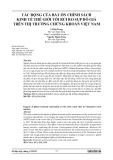
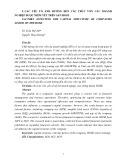
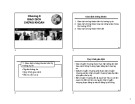
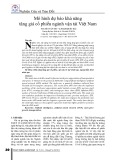
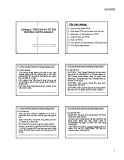
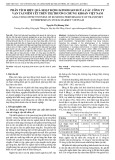

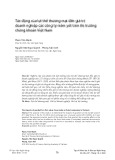
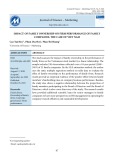
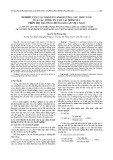
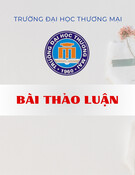
![Câu hỏi trắc nghiệm và bài tập Thị trường chứng khoán [mới nhất]](https://cdn.tailieu.vn/images/document/thumbnail/2025/20251001/kimphuong1001/135x160/75961759303872.jpg)
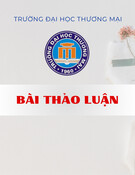

![Quỹ đầu tư chứng khoán: Đề tài thuyết trình [Mới Nhất]](https://cdn.tailieu.vn/images/document/thumbnail/2025/20250912/truongmy050404@gmail.com/135x160/80601757732705.jpg)



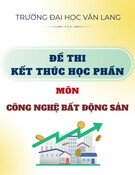



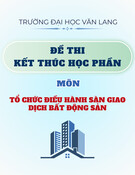

![Đề thi Đầu tư quốc tế học kì 1 năm 2024-2025 có đáp án (Đề 2) - [kèm đáp án chi tiết]](https://cdn.tailieu.vn/images/document/thumbnail/2025/20250822/kimphuong1001/135x160/84781755852396.jpg)
